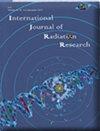Toxicity and cosmetic outcome in hypofractionated radiation therapy for ductal carcinoma in situ after breast-conserving surgery: a preliminary report
IF 0.4
4区 医学
Q4 RADIOLOGY, NUCLEAR MEDICINE & MEDICAL IMAGING
引用次数: 0
Abstract
Background : Hypofractionation radiotherapy (HFx) following breast - conserving surgery (BCS) in ductal carcinoma in situ (DCIS) has been shown to be safe in many retrospective studies. In this paper, we report our data and assess those outcomes to support the use of HFx in DCIS. Material and Methods : All patients with DCIS after BCS were treated with 4250cGy in 16 fractions to whole breast with tumor bed boost 1000cGy in 4 fractions. The toxicity was evaluated using CTCAE v.5.0. On the last day of radiation (day 0) then 1 and 6 months post radiation. The cosmesis was evaluated at 6 months. Results : Between July 2018 and December 2019 at our center, 33 patients were analyzed with a median follow up of 7.3 months. No toxicity of more than grade2 occurred. At day 0 and 1 month after radiation, 89% and 85% of patients had grade1 dermatitis and hyperpigmentation, respectively. For induration, 33% had grade1 at day 0, 29% at 1 month, and 44.8% at 6 months. Only 3% had grade2 induration at 1 month. In addition, 67% of the subjects had grade1 pruritus and 37% had grade1 pain at day0. Radiation oncologists assessed good - to - excellent cosmesis in 93% of these patients, while the 96.6% of patients self - evaluated as good to excellent without impact on their self - confidence. Conclusion : This prospective trial showed that HFx can be safely used in DCIS with no more than grade2 skin toxicity and good to excellent cosmesis.低分割放射治疗保乳术后导管原位癌的毒性和美容效果:初步报告
背景:许多回顾性研究表明,导管原位癌(DCIS)保乳手术(BCS)后低分割放疗(HFx)是安全的。在本文中,我们报告了我们的数据并评估了这些结果,以支持在DCIS中使用HFx。材料与方法:所有bccs后DCIS患者均接受4250cGy分16次至全乳治疗,肿瘤床强化1000cGy分4次。采用CTCAE v.5.0进行毒性评价。在放疗的最后一天(第0天)、放疗后1个月和6个月。6个月时评估美容效果。结果:2018年7月至2019年12月,我们中心分析了33例患者,中位随访时间为7.3个月。未发生2级以上毒性。放疗后第0天和第1个月,89%和85%的患者分别出现1级皮炎和色素沉着。对于硬结,33%在第0天为1级,29%在1个月,44.8%在6个月。只有3%的患者在1个月时出现2级硬结。此外,67%的受试者在第0天有1级瘙痒,37%的受试者有1级疼痛。放射肿瘤学家在93%的患者中评估了良好到优秀的美容,而96.6%的患者自我评估为良好到优秀,而不影响他们的自信。结论:本前瞻性试验表明HFx可安全用于DCIS,皮肤毒性不超过2级,美容效果良好。
本文章由计算机程序翻译,如有差异,请以英文原文为准。
求助全文
约1分钟内获得全文
求助全文
来源期刊

International Journal of Radiation Research
RADIOLOGY, NUCLEAR MEDICINE & MEDICAL IMAGING-
CiteScore
1.10
自引率
33.30%
发文量
42
期刊介绍:
International Journal of Radiation Research (IJRR) publishes original scientific research and clinical investigations related to radiation oncology, radiation biology, and Medical and health physics. The clinical studies submitted for publication include experimental studies of combined modality treatment, especially chemoradiotherapy approaches, and relevant innovations in hyperthermia, brachytherapy, high LET irradiation, nuclear medicine, dosimetry, tumor imaging, radiation treatment planning, radiosensitizers, and radioprotectors. All manuscripts must pass stringent peer-review and only papers that are rated of high scientific quality are accepted.
 求助内容:
求助内容: 应助结果提醒方式:
应助结果提醒方式:


